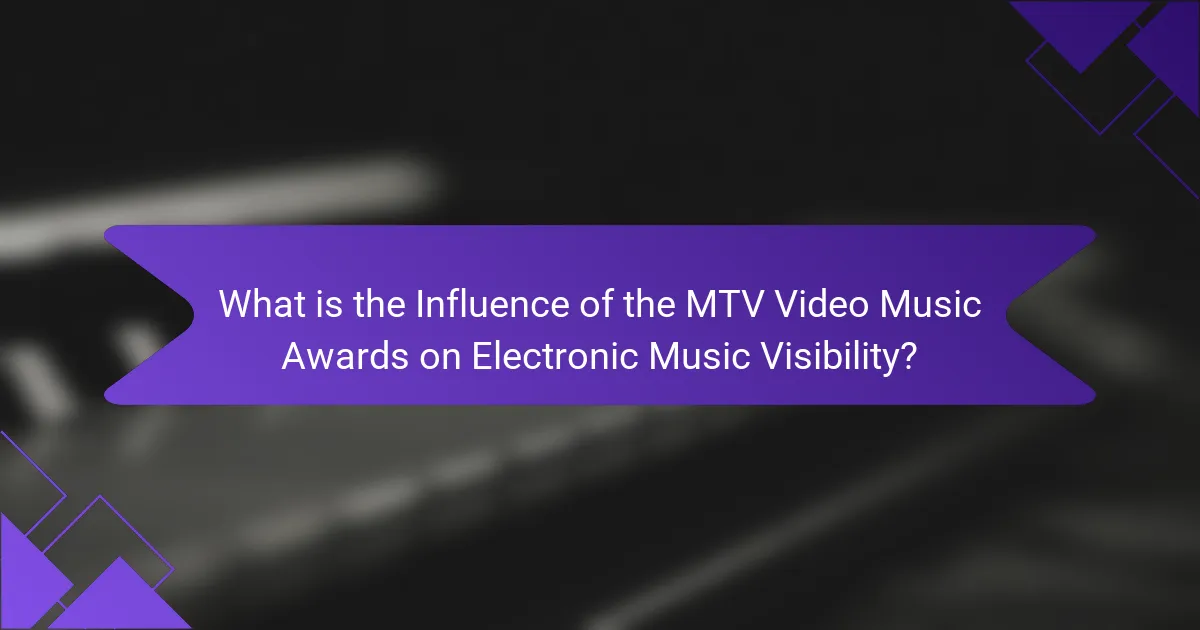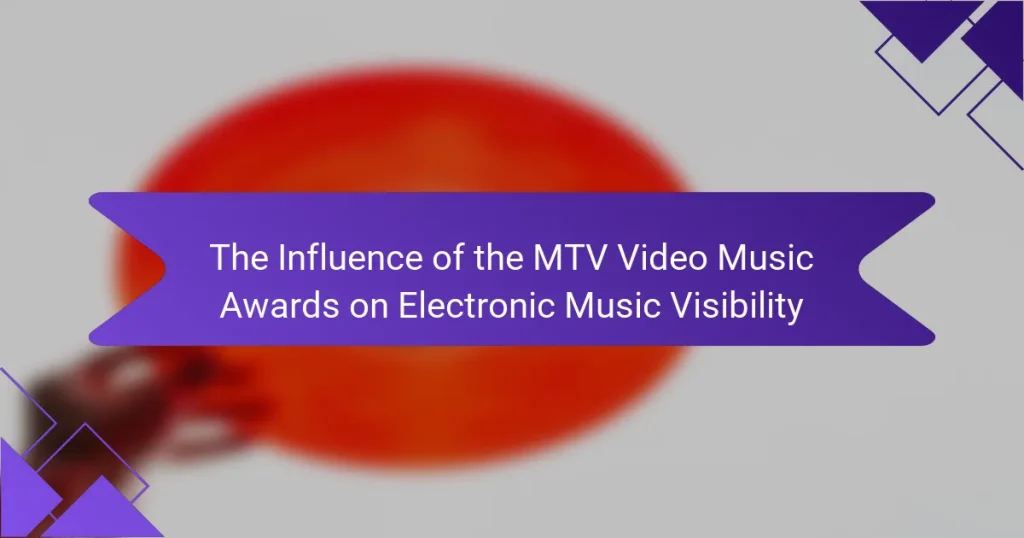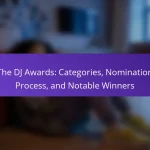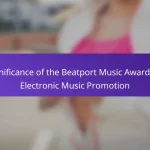The MTV Video Music Awards (VMAs) play a crucial role in enhancing the visibility of electronic music within the broader music industry. By showcasing a variety of genres, including electronic music, the VMAs elevate the profiles of electronic artists and facilitate significant media exposure. Notable performances, such as Daft Punk’s in 2013, have introduced electronic music to wider audiences, resulting in increased streaming and sales. Additionally, the recognition at the VMAs often leads to collaborations between electronic musicians and mainstream pop artists, further solidifying electronic music’s presence in popular culture.

What is the Influence of the MTV Video Music Awards on Electronic Music Visibility?
The MTV Video Music Awards significantly enhance electronic music visibility. The awards showcase a diverse range of musical genres, including electronic music. This exposure helps to elevate the profiles of electronic artists. Notable performances by electronic musicians at the VMAs have garnered substantial media attention. For example, Daft Punk’s performance in 2013 introduced them to a wider audience. Such visibility can increase streaming numbers and sales for electronic tracks. Additionally, collaborations between electronic artists and mainstream pop acts often emerge from VMA recognition. This trend further solidifies electronic music’s place in popular culture.
How have the MTV Video Music Awards historically impacted music genres?
The MTV Video Music Awards have historically influenced music genres by providing a platform for diverse styles. The awards have showcased emerging genres, such as hip-hop and pop-punk, elevating their visibility. For instance, the 1999 VMAs featured the first live performance by a prominent hip-hop artist, which marked a turning point for the genre. Additionally, the introduction of innovative music videos has shaped visual aesthetics across genres. The VMAs also encouraged cross-genre collaborations, expanding the musical landscape. Artists like Madonna and Nirvana have redefined genre boundaries at the awards. Overall, the MTV Video Music Awards have played a crucial role in shaping trends and promoting genre evolution in the music industry.
What role did the MTV Video Music Awards play in the rise of electronic music?
The MTV Video Music Awards significantly contributed to the rise of electronic music. The awards showcased electronic artists and their innovative music videos, increasing visibility. Iconic performances by artists like Daft Punk and The Chemical Brothers highlighted electronic music’s mainstream appeal. These performances attracted a broader audience and encouraged music industry recognition. The awards also celebrated the fusion of genres, integrating electronic elements into pop and rock. This cross-genre recognition helped legitimize electronic music in popular culture. Consequently, the MTV Video Music Awards became a pivotal platform for electronic music’s growth in the 1990s and 2000s.
How have past award winners influenced the popularity of electronic music?
Past award winners have significantly influenced the popularity of electronic music. Notable artists like Daft Punk and Calvin Harris have received MTV Video Music Awards. Their visibility increased through televised performances and award recognition. This exposure attracted mainstream audiences to electronic music. Collaborations with pop artists further mainstreamed the genre. For instance, Calvin Harris’s work with Rihanna brought electronic sounds to pop radio. The awards have also highlighted emerging electronic artists, fostering new talent. Consequently, the MTV Video Music Awards have played a crucial role in shaping the electronic music landscape.
Why is electronic music visibility important in the current music landscape?
Electronic music visibility is crucial in the current music landscape because it enhances recognition and acceptance within mainstream culture. Increased visibility allows electronic artists to reach broader audiences and gain commercial success. It also fosters collaboration with diverse genres, enriching the overall music scene. Moreover, visibility can lead to more opportunities for live performances and festival bookings. A study by the International Music Summit in 2021 highlighted that electronic music accounted for 30% of global music consumption. This statistic underscores the genre’s significant impact on the industry. As electronic music gains visibility, it helps shape trends and influences emerging artists. Ultimately, visibility supports the growth and sustainability of the electronic music community.
What benefits does increased visibility bring to electronic music artists?
Increased visibility brings significant benefits to electronic music artists. It enhances their reach to a broader audience. This can lead to increased streaming numbers and sales. Greater visibility also attracts collaboration opportunities with other artists. It can result in more performance bookings at festivals and events. Increased visibility often leads to media coverage and interviews. This boosts the artist’s brand recognition and reputation. According to a 2021 report by the International Music Summit, artists with higher visibility see a 30% increase in fan engagement.
How does electronic music visibility affect audience engagement and fanbase growth?
Electronic music visibility significantly enhances audience engagement and fanbase growth. Increased visibility through platforms like the MTV Video Music Awards exposes electronic artists to broader audiences. This exposure leads to higher streaming numbers and social media interactions. For instance, artists featured in high-profile events often see a spike in followers. A report by Nielsen Music found that visibility boosts streaming by up to 50%. Additionally, visibility fosters community building among fans. Engaged fans are more likely to attend live events, contributing to overall fanbase expansion.
What specific moments at the MTV Video Music Awards highlighted electronic music?
Notable moments at the MTV Video Music Awards that highlighted electronic music include Daft Punk’s performance in 2008. They showcased their signature electronic sound and innovative visuals. Another significant moment was Calvin Harris’s performance in 2016, which featured a live DJ set and electronic production. The 2013 collaboration between Avicii and other artists also emphasized the genre’s mainstream appeal. Additionally, the award for Best Electronic Dance Music Video has recognized key electronic music artists, enhancing visibility. These moments collectively demonstrate the growing influence of electronic music at the MTV Video Music Awards.
Which performances have been pivotal in showcasing electronic music at the awards?
The pivotal performances showcasing electronic music at the MTV Video Music Awards include Daft Punk in 2008 and Calvin Harris in 2016. Daft Punk’s performance featured their hit “One More Time” and highlighted their unique visual style. This performance significantly raised the profile of electronic music in mainstream culture. Calvin Harris performed “This Is What You Came For” with Rihanna, further solidifying the genre’s presence. These performances have been influential in bridging the gap between electronic music and broader audiences.
How have collaborations between electronic artists and mainstream musicians shaped visibility?
Collaborations between electronic artists and mainstream musicians have significantly enhanced visibility for electronic music. These partnerships introduce electronic sounds to broader audiences. For example, the collaboration between David Guetta and artists like Sia has led to chart-topping hits. Such successes have increased mainstream acceptance of electronic music. Additionally, these collaborations often receive extensive media coverage. This media attention further amplifies the reach of electronic artists. Events like the MTV Video Music Awards showcase these collaborations prominently. This exposure helps electronic artists gain recognition and credibility in the music industry.
How does the MTV Video Music Awards affect trends in electronic music?
The MTV Video Music Awards significantly influence trends in electronic music by showcasing popular electronic artists and their work. This visibility can lead to increased mainstream acceptance of electronic music genres. For instance, notable performances by artists like Calvin Harris and Skrillex at the VMAs have sparked interest in their music and similar styles. The awards also highlight collaborations between electronic artists and mainstream pop stars, further bridging the gap between genres. This crossover often results in a surge of electronic music in charts and playlists. Additionally, the VMAs create a platform for new talent, allowing emerging electronic artists to gain exposure. The event’s focus on innovative visuals and production can inspire trends in music production techniques. Overall, the MTV Video Music Awards play a crucial role in shaping the public’s perception and consumption of electronic music.
What trends in electronic music have emerged as a result of the MTV Video Music Awards?
The MTV Video Music Awards have significantly influenced trends in electronic music. Increased visibility of electronic artists has emerged due to high-profile performances. Collaborations between mainstream pop and electronic musicians have become more common. The awards have showcased innovative music videos that blend electronic music with visual art. This exposure has expanded audience demographics for electronic genres. Additionally, the integration of electronic elements in pop music has gained traction. The awards have also encouraged the use of technology in live performances. Overall, MTV has played a crucial role in elevating electronic music within the mainstream music industry.
How do award nominations and wins influence emerging electronic artists?
Award nominations and wins significantly enhance the visibility of emerging electronic artists. Recognition from prestigious awards like the MTV Video Music Awards can lead to increased media coverage. This media attention often results in a larger audience reach. Additionally, winning awards can validate an artist’s work, boosting their credibility. Increased credibility may attract collaborations with established artists. Collaborations can further elevate an artist’s profile in the industry. Furthermore, award recognition can lead to greater opportunities for performances and festivals. Historical data shows that nominated artists often see a surge in streaming numbers post-nomination.
What strategies can electronic music artists use to leverage MTV Video Music Awards exposure?
Electronic music artists can leverage MTV Video Music Awards exposure through strategic collaborations and promotional activities. Collaborating with mainstream artists increases visibility and reach. This can lead to new audiences discovering their music. Additionally, artists should use social media to engage fans during and after the event. Posting behind-the-scenes content and reactions can create buzz.
Participating in interviews and red carpet events also enhances visibility. Artists can share insights about their work and connect with fans. Creating exclusive content related to the event can further capitalize on the exposure. For example, a remix of a popular song performed at the awards can attract attention.
Using the awards as a platform for announcements, such as new projects or tours, can maximize impact. In 2021, electronic artists like Marshmello gained significant followers after high-profile performances at the VMAs. This highlights the potential for increased fan engagement and growth through strategic exposure.
How can artists maximize their visibility during the awards season?
Artists can maximize their visibility during the awards season by leveraging social media platforms effectively. Engaging with fans through live streams and Q&A sessions increases interaction. Collaborating with influencers can broaden reach and attract new audiences. Participating in interviews and podcasts enhances exposure to different demographics. Creating visually appealing promotional materials helps capture attention. Attending pre-award events and parties allows networking opportunities. Utilizing hashtags related to the awards can improve discoverability. Consistent branding across all platforms reinforces identity and message.
What best practices should electronic artists follow to engage with fans post-awards?
Electronic artists should actively engage with fans post-awards through social media interaction. They can share behind-the-scenes content from the awards to create a personal connection. Posting thank-you messages to fans and collaborators fosters appreciation and loyalty. Hosting live Q&A sessions allows fans to ask questions directly, enhancing engagement. They can also release exclusive content, such as remixes or bonus tracks, to reward their audience. Collaborating with other artists for joint performances or projects can broaden their reach. Regular updates about future projects keep fans informed and excited. These practices are supported by research indicating that direct interaction increases fan loyalty and engagement in the music industry.
The MTV Video Music Awards serve as a pivotal platform for enhancing the visibility of electronic music within the mainstream music landscape. This article examines the historical impact of the VMAs on various music genres, particularly focusing on how notable performances and collaborations have propelled electronic artists into the spotlight. Key moments, such as Daft Punk’s and Calvin Harris’s performances, are highlighted to illustrate the awards’ role in shaping trends and increasing audience engagement. Additionally, the article discusses the benefits of visibility for electronic music artists, including increased streaming numbers and opportunities for collaboration, ultimately contributing to the genre’s growth and sustainability in the current music industry.


